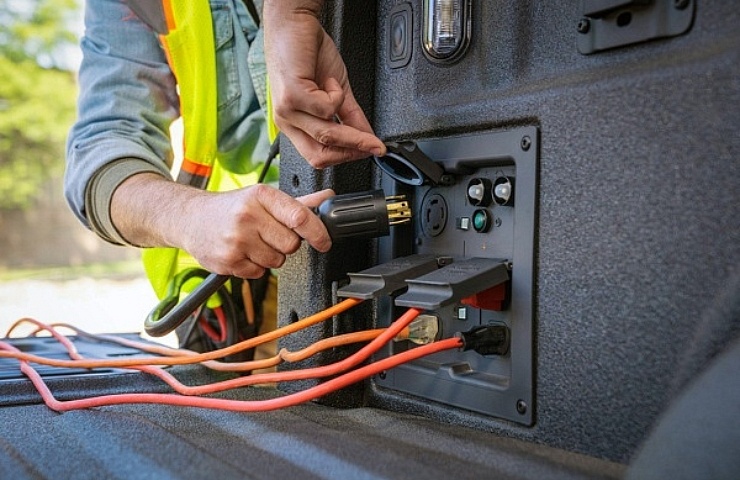The first cigarette lighters were installed in automobiles in the 1920s. And they were designed for that very purpose: to have a smoke while in transit.

A 1921 patent drawing for lighting “cigars and the like” in the car.
However, when the age of portable consumer electronics arrived in the 1950s and 1960s, motorists developed one of the outstanding hacks in automotive history. They turned the cigarette lighter into an auxiliary electric power source for a map light, electric shaver, or portable coffee maker.
Shop now for simple 12-volt plug-in devicesIn the era of smartphones, it feels like we can’t survive without having access to a charge. Vehicles don’t have ashtrays anymore, but power plugs and USB outlets are ubiquitous. Manufacturers are now taking cabin-based electricity supply to the next level by equipping cars and trucks with actual three-prong 120-volt outlets—no adapters or 12-volt inverters necessary.
Remote Truck-Supplied Power for a Job Site

Ford’s “Pro Power Onboard” system provides up to 7.2 kilowatts of power directly from an F-150.
Ford offers the 2021 F-150 pickup with a choice of three onboard power options. The system is called “Pro Power Onboard.”
- For the pure gas-powered F-150, Ford offers an optional 2-kilowatt system with two 120-volt plugs by the tailgate. The internal combustion engine needs to be running to generate power.
- The gas-electric hybrid F-150 comes standard with a 2.4 kW system. With hybrids, the engine kicks in only when the larger battery pack gets low.
- The third choice is also for a hybrid. The hybrid offers the option to ramp up to a 7.2-kW system.
What Can You Power?
To put this power into perspective, most RVs come with generators that put out three or more kilowatts. A contractor in the field could run a 900-watt drill, a circular saw with 1,800 watts, and an angle grinder at 900 watts. Running them all at once would draw 3,600 watts (or 3.6 kilowatts). That’s half the capacity of Ford’s 7.2 kW system.
Car and Driver recently tested the 7.2 kW system by running a coffee maker, vacuum, television, web modem and router, fridge, garage fridge, a few lamps, and a 1,400-watt iron. The author reported:
e F-150 ran everything simultaneously and could have handled mor
The higher-output kW system on the hybrid comes with four 20-amp, 120-volt outlets plus a 30-amp, 240-volt outlet. That makes it functional for a construction site or your favorite fishing hole. Your home’s clothes dryer and oven most likely use a 240-volt circuit. Many welders also utilize a 240-volt source for tools.
Ford is not alone in offering new onboard outlets, although not quite as capable as what comes with the new F-150s. Chevrolet trucks have a built-in 120-volt outlet capable of running machinery and tools up to 150 watts. That is enough to power a game console and laptop for extended road trips. Ram Trucks offer a similar optional inverter that supplies one outlet with up to 400 watts. The inverters are built-in, so all you need to do is plug in and power up.
What About Aftermarket Inverters?

Car inverters either plug into the standard round power plug or connect directly to the car battery posts.
Are you eager to plug in a three-prong power tool to a vehicle’s 12-volt supply, such as a cigarette lighter? Then you’ll need an inverter.
Shop now for vehicle invertersA car inverter is a device that converts a 12-volt DC power from your vehicle to the standard 120 AC volts used by most household appliances. The simplest and least expensive inverters offer a single outlet while heavy-duty units provide thousands of watts and space for multiple plugs.
These car inverters plug into the standard round power plug inside the vehicle. Advanced units offer a set of alligator clips to connect directly to the car battery posts. That is best when the car is stationary and stopped, like at a construction site or while camping. Please keep inverters uncovered with adequate space to avoid heating them up.
If you overwhelm the inverter with too many high-power tools, a circuit-breaker in the device will trip. Let everything cool down, reset the breaker, and lower the power demand.
Low-power devices used for just a few minutes draw minimal energy from a standard car battery. But for more than a few minutes, it’s best to keep the engine running to maintain the battery’s state of charge.
EVs Have Bigger Batteries

Kia’s upcoming purpose-built EV will offer a power-takeoff capability. The feature could become commonplace for electric cars.
Pure electric cars might offer a new opportunity for “power take-off,” using massive battery packs as the source. If the grid goes down in an emergency, EV owners can conceivably use the vehicle to keep smartphones and laptops charged—and even a refrigerator or small AC running.
While owners can use an EV’s traditional onboard power plug for a 120-volt supply, the latest generation of purpose-built electrics—like the Kia EV6—are equipped with a 3.6-kilowatt “vehicle-to-load” feature.
A 120-volt supply works fine for a few smartphone chargers, but the 3.6-kW source is enough for a broader range of power-hungry appliances. Today’s most capable electric vehicles have batteries big enough to supply the average American home with all its energy needs for more than two days. Several automakers, including Ford and General Motors, are planning to offer pure electric pickups with at least that much capability.
Keep in mind that electric vehicles don’t have combustion engines or tailpipes. So an electric car can work as a generator inside your garage or at a campsite—without concerns about nasty fumes.





